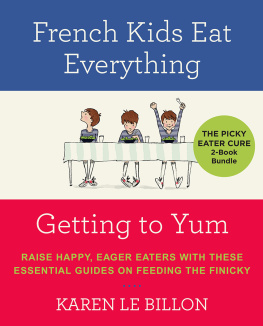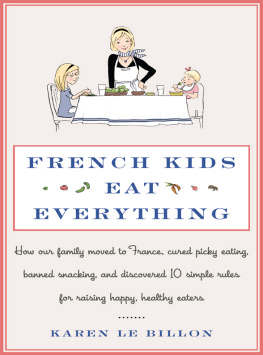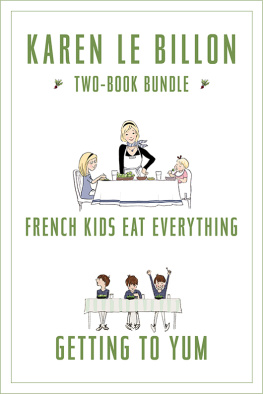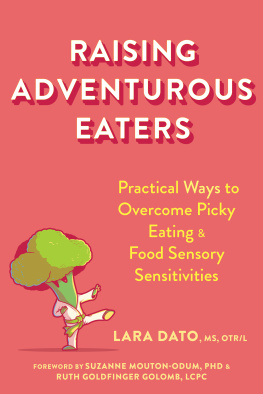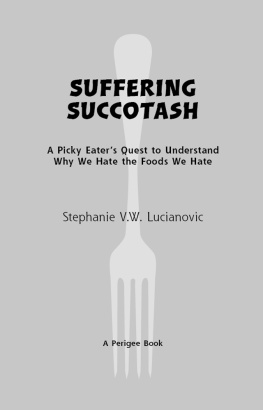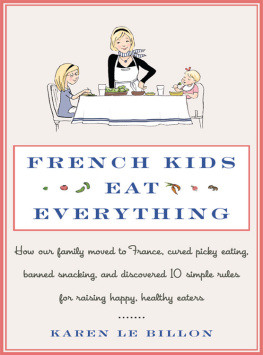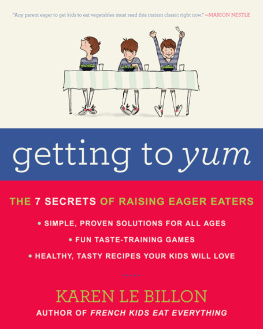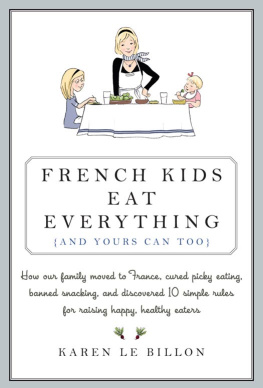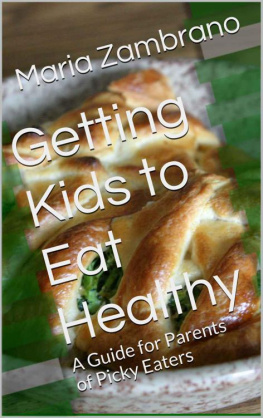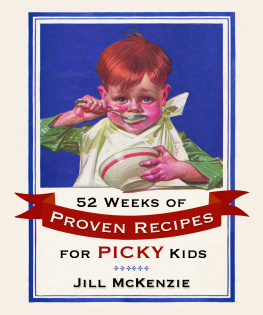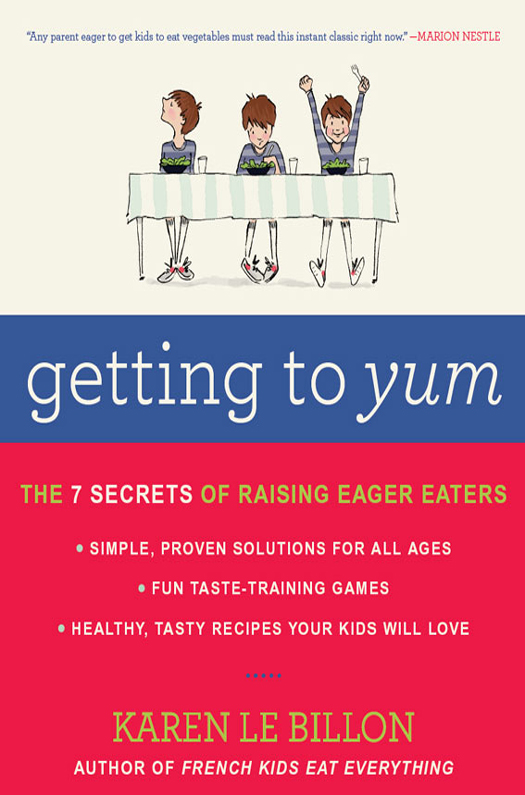To Sophie and Claire, my best taste testers
Contents
GETTING TO YUM GAMES
O BESITY RATES HAVE SKYROCKETED IN THE PAST SEVERAL DECADES, largely driven by unhealthful lifestyle behaviors in an increasingly automated on the go world. Aggressive food marketing has also fueled the childhood obesity epidemic by inducing children to crave high-calorie, low-nutrient foods and providing families with economic incentives to purchase them. Now more than ever, parents need effective strategies to help their children develop healthful eating habits for life.
As a pediatrician with expertise in pediatric obesity, one of the questions I am frequently asked is How do we get children to eat what is good for them? While this might seem like a simple question, the answer is incredibly complex. Karen Le Billon offered some thought-provoking ideas in her New York Times article Why French Parents Are Superior (in One Way). In it, Karen described how French parents effectively teach their children that good-for-you foods taste good, while American families often unwittingly do the opposite. In striking contrast to the limited repertoire of tastes preferred by many American children, the majority of French children learn to accept a large variety of tastes, flavors, and textures from an early ageand most of what they eat is healthy. As a matter of fact, North American children are three times more likely to be overweight than French children. Intrigued, I picked up a copy of Karens first book, French Kids Eat Everything, and was transported to a small French town filled with wonderful flavors where Karen and her husband successfully converted their two children from picky eaters to foodie omnivores with the help of forward-thinking, government-backed nutrition policies and savvy parenting strategies.
In her long-awaited second book, Getting to Yum, Karen translates the current scientific evidence and her own experience transforming her childrens eating behaviors in France into a treasure trove of valuable lessons to help parents everywhere to do the same. Her Seven Secrets for Raising Eager Eaters offer carefully researched, evidence-based yet highly practical advice to help parents tame finicky eaters. Karen provides a great explanation of how children develop tastes and how this impacts their willingness to accept new foods. She then offers insightful and practical strategies to get children to try new foods through taste-training experiments that teach children (and their parents) important but often-neglected food experience skills in a non-threatening and fun way. I was particularly impressed to see that Karen adopts the avant-garde concept of parents themselves marketing healthy foods to children; the latest research has shown this to be a much more effective approach than sneaking foods into childrens diets.
As a medical educator and the mother of four children with very distinct personalities and taste preferences, I am always looking for evidence-based, adaptable, and user-friendly materials I can use at home and with my families at work. My sometimes-finicky children and I have had a lot of fun trying some of the taste experiments in this book (they recently discovered they like/are okay with grapefruit), and my kids have declared several of our test recipes positively yummy.
Getting to Yum is a must-read for parents who want to not only teach but also show their children that healthful foods can truly be yummy. This book beckons families to embark on a taste discovery adventure and methodically shows them that food can be a great source of joy and exploration. I thoroughly enjoyed Getting to Yum with my family and hope that your family will, too. Welcome aboard!
Dr. Jennifer Cheng
Pediatrician and Clinical Director
One Step Ahead (Preventive Weight Management) Program
Harvard Medical School
W HEN I FIRST MET JESSICA, HER 3-YEAR-OLD SON, LUCAS, WOULD not eat a single vegetable. Not one! Among Lucass list of forbidden foods were meat (with the exception of hot dogs), mushy foods (even roasted potatoes), and anything green. Jessica was at her wits end. The dinner table feels like a battleground. I leave feeling so stressed. My husband and I dont know what else to do, she told me.
A few months after adopting the taste-training method in this book, Lucass eating habits dramatically improved. Previously off-limits foods were now among Lucass favorites: green beans, oranges, grapefruiteven raw spinach. Best of all, Lucass baby sister, who benefited from taste training right from the start, happily eats anything put in front of her. As a result of taste training, Jessica explained, weve adopted new routines that have changed our familys eating habits for the better.
What is taste training, and why is it useful for parents?
TASTE TRAINING IS A HANDS-ON, PRACTICAL APPROACH TO FOOD EDUCATION THAT uses games and fun activities to help children learn to like healthy foods. The underlying principle is that children can learn to eat well, just as they learn to read. The idea that taste can be taught is a hopeful, positive message. The goal is simple: children will enjoy eating healthy foods because they want to (not because they have to). Your children will develop positive eating routines (how, where, and when to eat) that foster balanced appetites and healthy attitudes to food. Theyll be healthy, happy, savvy eaters.
Of course, many food culturesthe French, the Italians, the Japanese, to name a fewhave been practicing their version of taste training for generations. Its only recently that scientists and educators have studied the effects of taste training, and explained how and why it works so well. Researchers have spent the past few decades doing hundreds of amazing (and sometimes downright funny) experiments on babies and children: feeding babies slightly acidic water (their sour face looks just like an adults); asking toddlers to eat fake green grasshopper icing (they will, happily); or dyeing food blue to see if peer pressure works to encourage reluctant kids to eat scary things (it does).
The core message of the scientific research on taste training is simple and inspiring: kids can actually learn to like new tastes (even if they are cautious about them at first). And thats not all. Specific taste-training techniques improve childrens eating habits, make them more willing to try new foods, and change their long-term eating habits for the better. Kids who have gone through taste training eat healthy foods more regularly and eagerly, even months after the taste training is over.In fact, scientific studies show that taste training works better than nutrition-focused education methods.
Our familys story: Curing picky eating
HOW DO I KNOW SO MUCH ABOUT KIDS AND FOOD? MY BEST QUALIFICATION is being a mom to two wonderful daughters who were both picky eaters (one of those blessed obstacles that was a source of enormous stress when I was a new mother). Im also a university professor, so I love digging for answers to complex problems. These two parts of my identity collided when my husband and I moved to France with our two young daughters, who were then subsisting on a beige food diet (pasta, Cheerios, buttered toast, and crackersyou get the idea). Because taste training is widespread in French homes and schools, my daughters received a food education similar to what I describe in this book. Within a year, the two girls (then 5 and 2) were eatingand lovinga huge range of foods, including beet salad, creamed spinach, broccoli, and mussels. (No, I am not making this up!)
I was so inspired by the positive change in our familys eating habitsand convinced that we had learned life-changing lessons that could be of use to parents worldwidethat I wrote a book about our experience,

